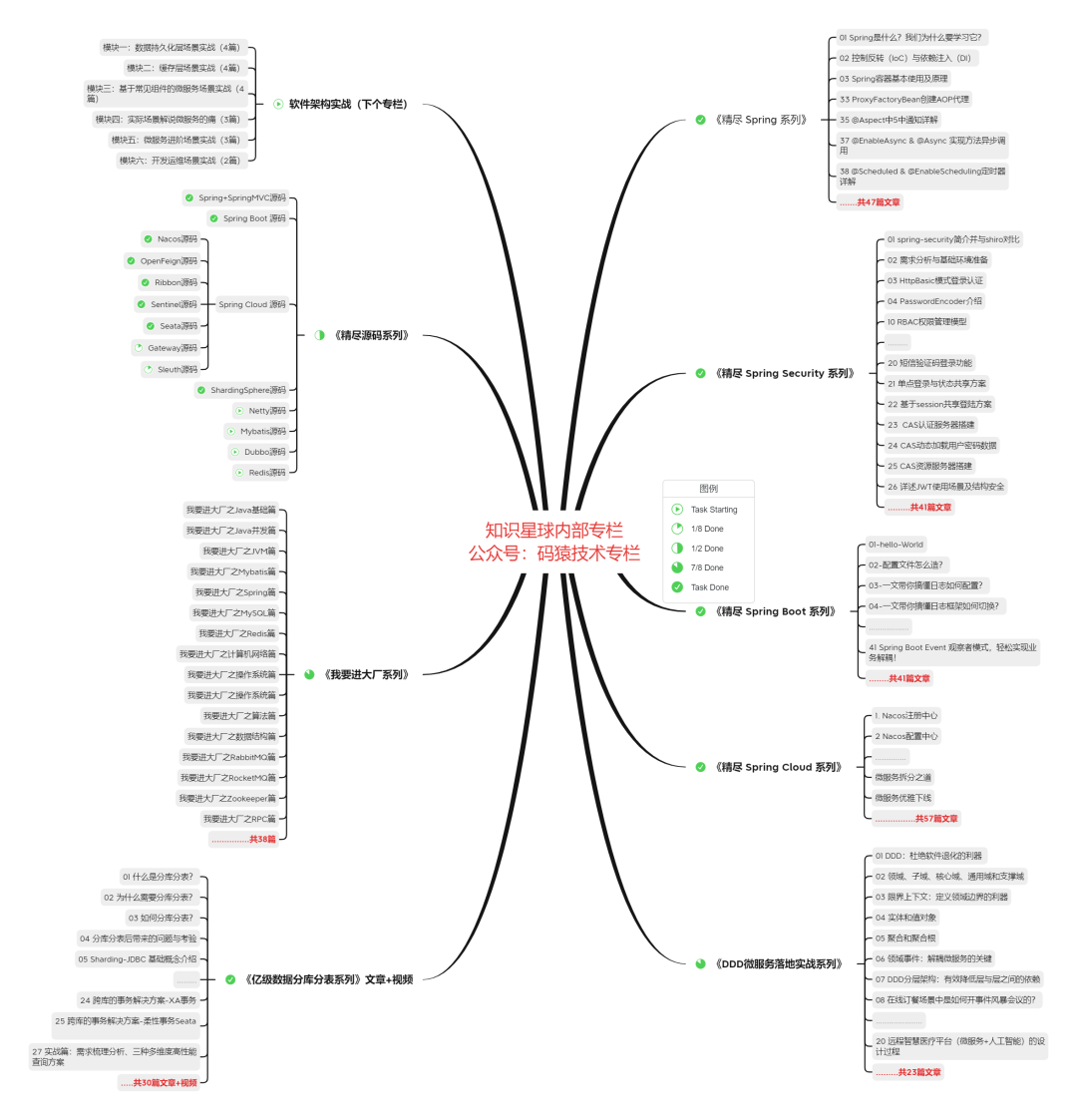作者:微信小助手
发布时间:2023-05-08T11:53:04
上面是 注解的属性 1、controller中添加 2、nacos配置中心中配置 3、验证, 修改配置中心后,可以不重启动,刷新配置 4、去掉 为了实现动态刷新配置,主要就是想办法达成以下两个核心目标: 通过打上断点查看堆栈可知: 1、因为Class被加上了 2、 小结: 从这边的代码中可以印证了上面的说法,创建后的Bean会缓存到scope的cache中,优先从缓存中获取,如果缓存中是null, 则重新走一遍create bean的流程。 上面的在getBean的时候依赖到RefreshScope这个Bean,那么这个Bean是在什么时候加入到Spring Bean中的呢?答案就是 1、配置中心发生变化后,会收到一个 2、refresh方法最终调用destroy方法,清空之前缓存的bean 上面是这个RefreshScope实现动态刷新大致的原理,其中里面还有很多细节,可能需要留给大家自己debug去深入理解。 陈某每一篇文章都是精心输出,如果这篇文章对你有所帮助,或者有所启发的话,帮忙点赞、在看、转发、收藏,你的支持就是我坚持下去的最大动力! 另外陈某的知识星球开通了,公众号回复关键词:知识星球 获取限量20元优惠券加入只需109元,星球回馈的价值巨大,目前更新了Spring全家桶实战系列、亿级数据分库分表实战、DDD微服务实战专栏、我要进大厂、Spring,Mybatis等框架源码、架构实战22讲、精尽RocketMQ等....每增加一个专栏价格将上涨20元 关注公众号:【码猿技术专栏】,公众号内有超赞的粉丝福利,回复:加群,可以加入技术讨论群,和大家一起讨论技术,吹牛逼!@RefeshScope这个注解想必大家都用过,在微服务配置中心的场景下经常出现,他可以用来刷新Bean中的属性配置,那大家对他的实现原理了解吗?它为什么可以做到动态刷新呢?注解的作用
@RefreshScope注解是Spring Cloud中的一个注解,用来实现Bean中属性的动态刷新。/**
* Convenience annotation to put a <code>@Bean</code> definition in
* {@link org.springframework.cloud.context.scope.refresh.RefreshScope refresh scope}.
* Beans annotated this way can be refreshed at runtime and any components that are using
* them will get a new instance on the next method call, fully initialized and injected
* with all dependencies.
*
* @author Dave Syer
*
*/
@Target({ ElementType.TYPE, ElementType.METHOD })
@Retention(RetentionPolicy.RUNTIME)
@Scope("refresh")
@Documented
public @interface RefreshScope {
/**
* @see Scope#proxyMode()
* @return proxy mode
*/
ScopedProxyMode proxyMode() default ScopedProxyMode.TARGET_CLASS;
}RefreshScope的源码,该注解被@Scope注解使用,@Scope用来比较Spring Bean的作用域,具体使用参考相关文章。proxyMode默认使用TARGET_CLASS作为代理。实例
@RefreshScope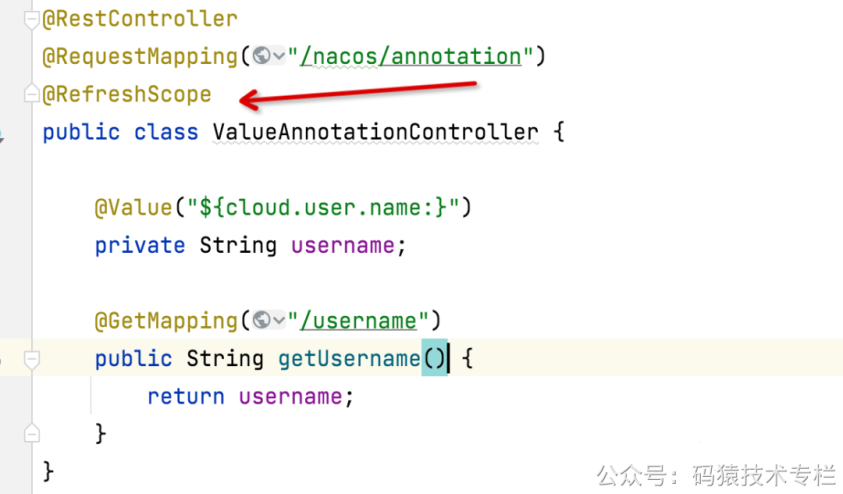
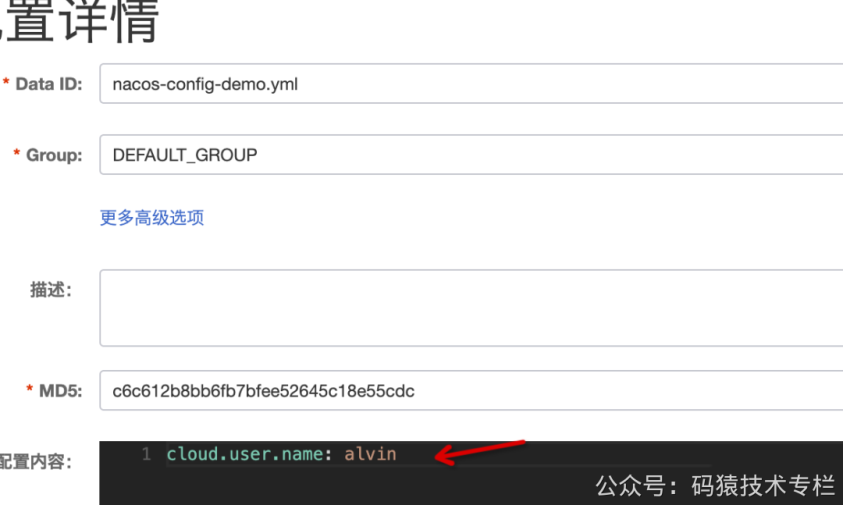

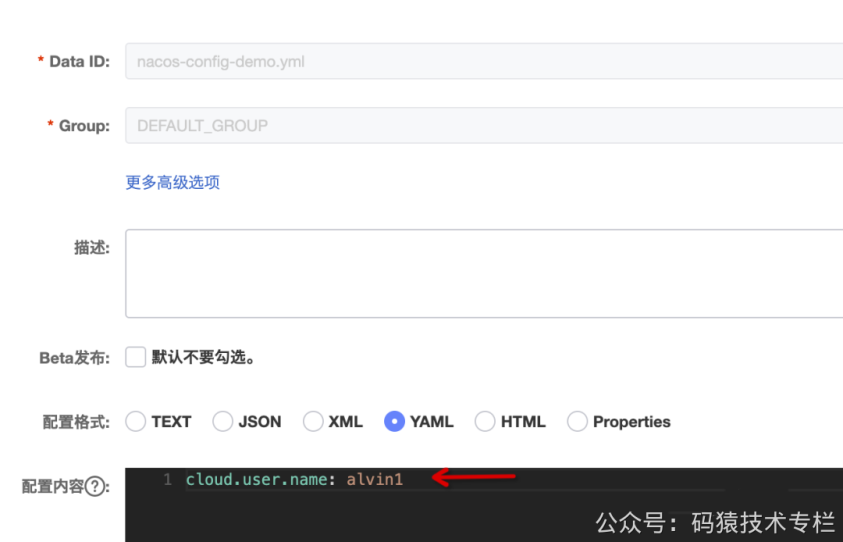

@RefreshScope 就不会自动刷新。原理解析
@RefreshScope主要就是基于@Scope注解的作用域代理的基础上进行扩展实现的,加了@RefreshScope注解的类,在被Bean工厂创建后会加入自己的refresh scope 这个Bean缓存中,后续会优先从Bean缓存中获取,当配置中心发生了变更,会把变更的配置更新到spring容器的Environment中,并且同事bean缓存就会被清空,从而就会从bean工厂中创建bean实例了,而这次创建bean实例的时候就会继续经历这个bean的生命周期,使得@Value属性值能够从Environment中获取到最新的属性值,这样整个过程就达到了动态刷新配置的效果。关注公众号:码猿技术专栏,回复关键词:1111 获取阿里内部Java性能调优手册~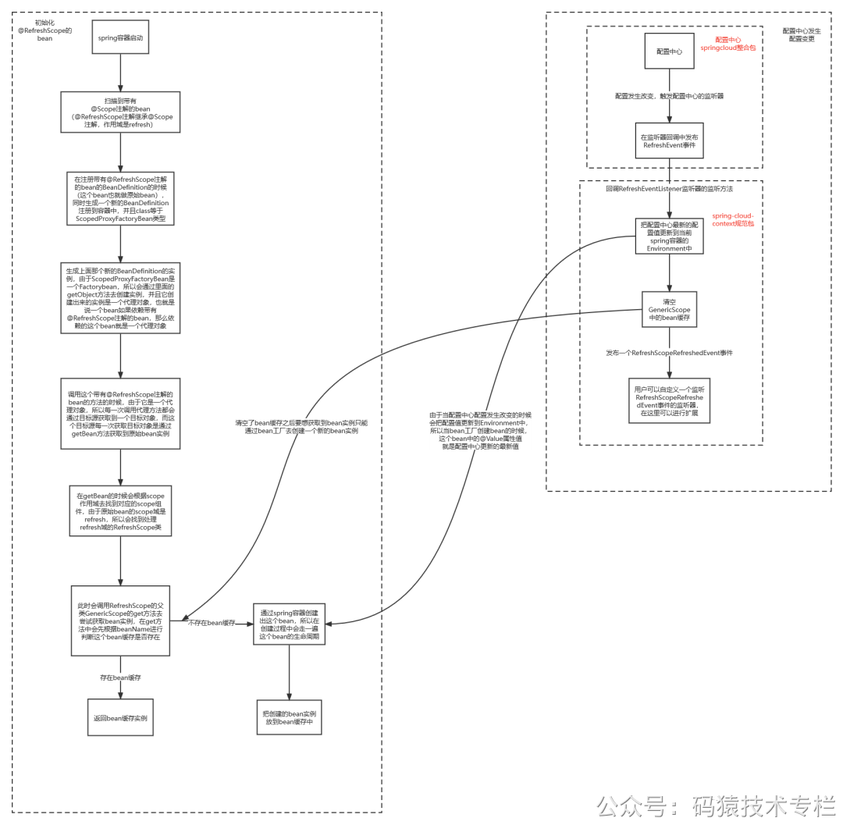
获取RefreshScope注解的Bean
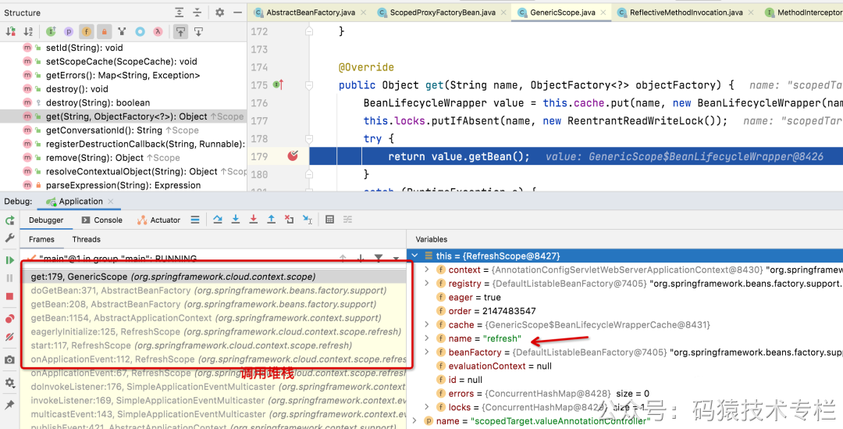
@RefreshScope注解,那么这个BeanDefinition信息中的scope为refresh,在getBean的的时候会单独处理逻辑。public abstract class AbstractBeanFactory extends FactoryBeanRegistrySupport implements ConfigurableBeanFactory {
protected <T> T doGetBean(
String name, @Nullable Class<T> requiredType, @Nullable Object[] args, boolean typeCheckOnly)
throws BeansException {
// 如果scope是单例的情况, 这里不进行分析
if (mbd.isSingleton()) {
.....
}
// 如果scope是prototype的情况, 这里不进行分析
else if (mbd.isPrototype()) {
......
}
// 如果scope是其他的情况,本例中是reresh
else {
String scopeName = mbd.getScope();
if (!StringUtils.hasLength(scopeName)) {
throw new IllegalStateException("No scope name defined for bean '" + beanName + "'");
}
// 获取refresh scope的实现类RefreshScope,这个类在哪里注入,我们后面讲
Scope scope = this.scopes.get(scopeName);
if (scope == null) {
throw new IllegalStateException("No Scope registered for scope name '" + scopeName + "'");
}
try {
// 这边是获取bean,调用的是RefreshScope中的的方法
Object scopedInstance = scope.get(beanName, () -> {
beforePrototypeCreation(beanName);
try {
return createBean(beanName, mbd, args);
}
finally {
afterPrototypeCreation(beanName);
}
});
beanInstance = getObjectForBeanInstance(scopedInstance, name, beanName, mbd);
}
catch (IllegalStateException ex) {
throw new ScopeNotActiveException(beanName, scopeName, ex);
}
}
}
catch (BeansException ex) {
beanCreation.tag("exception", ex.getClass().toString());
beanCreation.tag("message", String.valueOf(ex.getMessage()));
cleanupAfterBeanCreationFailure(beanName);
throw ex;
}
finally {
beanCreation.end();
}
}
return adaptBeanInstance(name, beanInstance, requiredType);
}
}RefreshScope继承成了GenericScope类,最终调用的的是GenericScope的get方法public class GenericScope
implements Scope, BeanFactoryPostProcessor, BeanDefinitionRegistryPostProcessor, DisposableBean {
@Override
public Object get(String name, ObjectFactory<?> objectFactory) {
// 将bean添加到缓存cache中
BeanLifecycleWrapper value = this.cache.put(name, new BeanLifecycleWrapper(name, objectFactory));
this.locks.putIfAbsent(name, new ReentrantReadWriteLock());
try {
// 调用下面的getBean方法
return value.getBean();
}
catch (RuntimeException e) {
this.errors.put(name, e);
throw e;
}
}
private static class BeanLifecycleWrapper {
public Object getBean() {
// 如果bean为空,则创建bean
if (this.bean == null) {
synchronized (this.name) {
if (this.bean == null) {
this.bean = this.objectFactory.getObject();
}
}
}
// 否则返回之前创建好的bean
return this.bean;
}
}
}RefeshScope Bean的创建
RefreshAutoConfiguration。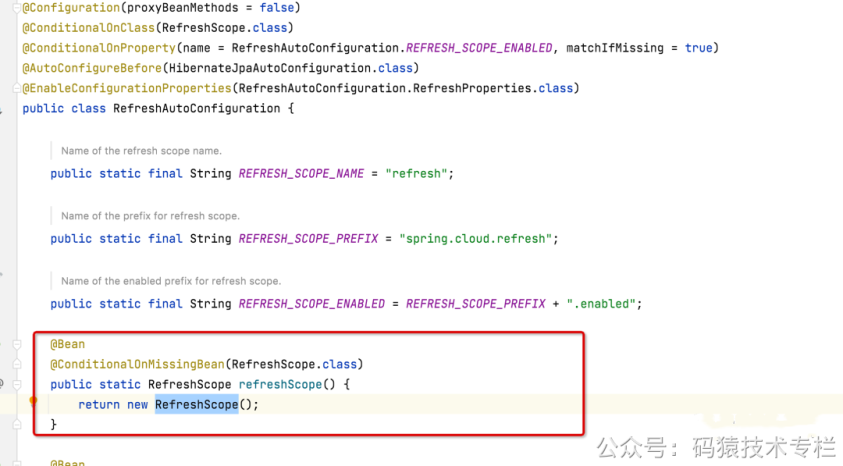
配置中心刷新后刷新Bean缓存
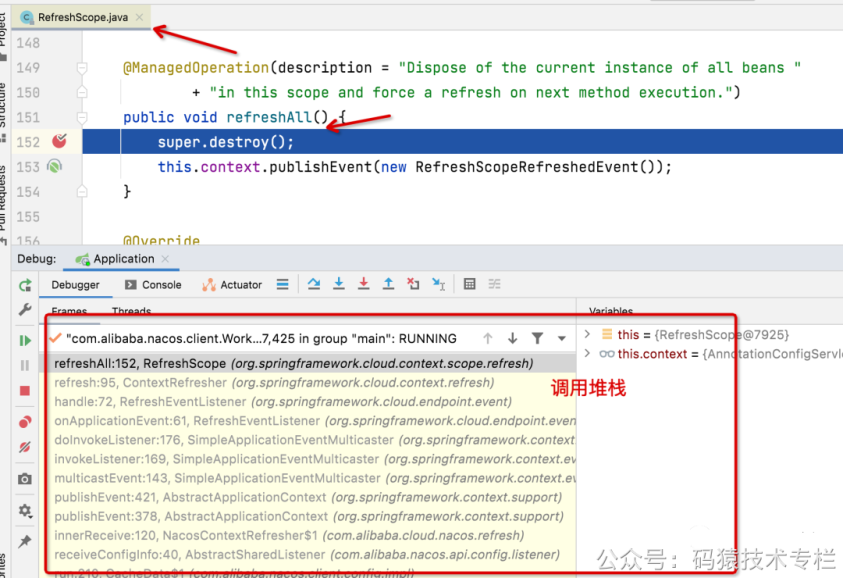
RefreshEvent事件,RefreshEventListner监听器会监听到这个事件。public class RefreshEventListener implements SmartApplicationListener {
........
public void handle(RefreshEvent event) {
if (this.ready.get()) { // don't handle events before app is ready
log.debug("Event received " + event.getEventDesc());
// 会调用refresh方法,进行刷新
Set<String> keys = this.refresh.refresh();
log.info("Refresh keys changed: " + keys);
}
}
}
// 这个是ContextRefresher类中的刷新方法
public synchronized Set<String> refresh() {
// 刷新spring的envirionment 变量配置
Set<String> keys = refreshEnvironment();
// 刷新其他scope
this.scope.refreshAll();
return keys;
}public class RefreshScope extends GenericScope
implements ApplicationContextAware, ApplicationListener<ContextRefreshedEvent>, Ordered {
@ManagedOperation(description = "Dispose of the current instance of all beans "
+ "in this scope and force a refresh on next method execution.")
public void refreshAll() {
// 调用父类的destroy
super.destroy();
this.context.publishEvent(new RefreshScopeRefreshedEvent());
}
}
@Override
public void destroy() {
List<Throwable> errors = new ArrayList<Throwable>();
Collection<BeanLifecycleWrapper> wrappers = this.cache.clear();
for (BeanLifecycleWrapper wrapper : wrappers) {
try {
Lock lock = this.locks.get(wrapper.getName()).writeLock();
lock.lock();
try {
// 这里主要就是把之前的bean设置为null, 就会重新走createBean的流程了
wrapper.destroy();
}
finally {
lock.unlock();
}
}
catch (RuntimeException e) {
errors.add(e);
}
}
if (!errors.isEmpty()) {
throw wrapIfNecessary(errors.get(0));
}
this.errors.clear();
}总结
最后说一句(别白嫖,求关注)
